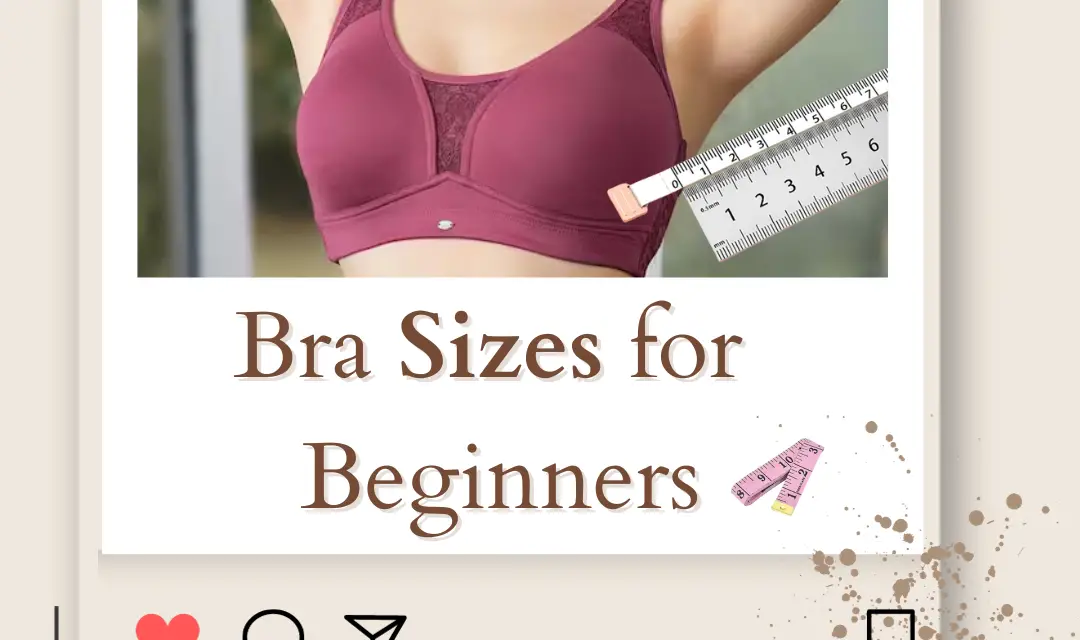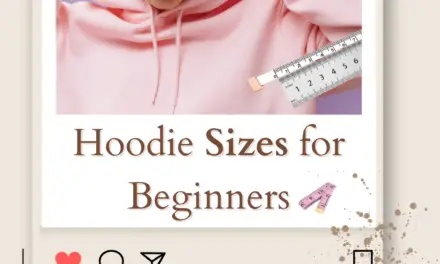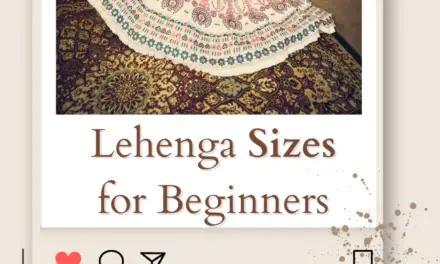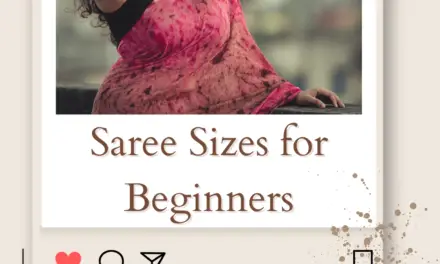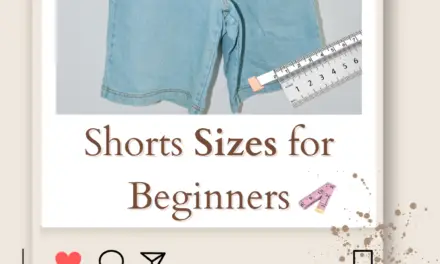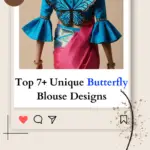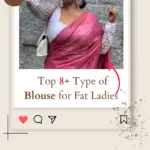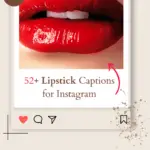Navigating the Lingerie world of bra sizes can be overwhelming, but fear not! Understanding your bra size is essential for comfort and confidence. Here’s a breakdown to help you find that perfect fit: Note: always opt for Best Bra Brands for the perfect outfit.
Understanding Bra
- Band Size: The number in your bra size (e.g., 34, 36) represents your band size. Measure around your ribcage, right under your bust, ensuring the tape is snug but not tight.
- Cup Size: The letter (A, B, C, etc.) corresponds to your cup size, indicating the difference between your band size and your bust measurement. For instance, if your band size is 34 inches and your bust measures 36 inches, you may be a B cup.
Take Accurate Bra Measurements
- Band Measurement: Use a soft measuring tape to measure around your ribcage, just below your bust. Round up to the nearest even number.
- Bust Measurement: Measure around the fullest part of your bust while keeping the tape comfortably snug but not tight. Make sure the tape is parallel to the ground.
Decoding Different Bra Sizes
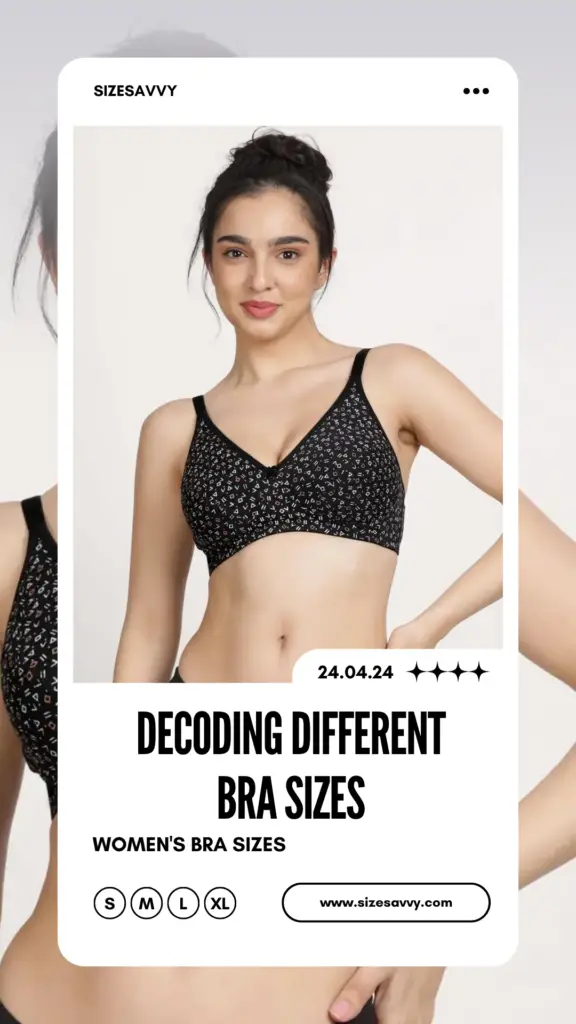
Bra sizes, with their combination of numbers and letters, might seem like a secret language.
1. Standard Bra:
- A, B, C, D… What do these letters mean? These letters denote your cup size, representing the volume of your breasts. For example, a ‘C’ cup is larger than a ‘B’ cup.
- 32, 34, 36… What about these numbers? The number refers to your band size, which is the circumference of your ribcage just under your bust. It’s crucial to provide the right support.
2. Different Bra Combinations:
- 32A, 34B, 36C, 38D… What’s the significance? The first number (32, 34, etc.) signifies your band size. The letter (A, B, etc.) represents your cup size. For instance, a 34B and a 36A have different band sizes but the same cup volume.
3. Plus Size Bra:
- Understanding larger band sizes: Plus-size bras often start from 38 and go up. The key is a supportive band and well-structured cups for ample comfort.
4. Sports Bra:
- Focus on support: Sports bras emphasize support. They often come in sizes like small, medium, large, etc., with corresponding cup sizes. Ensure a snug fit for minimal movement during activities.
5. Nursing Bra:
- Adaptability is essential: Nursing bras have convenient features like clasps for easy breastfeeding. They usually come with stretchable cups to accommodate changes in breast size during lactation.
6. Specialty Bra:
- For unique needs: There are specialty bras like mastectomy bras (for post-surgery), minimizer bras (to reduce the appearance of bust size), and balconette bras (offering a flattering lift). These cater to specific needs and body types.
Women’s Bra Size Charts
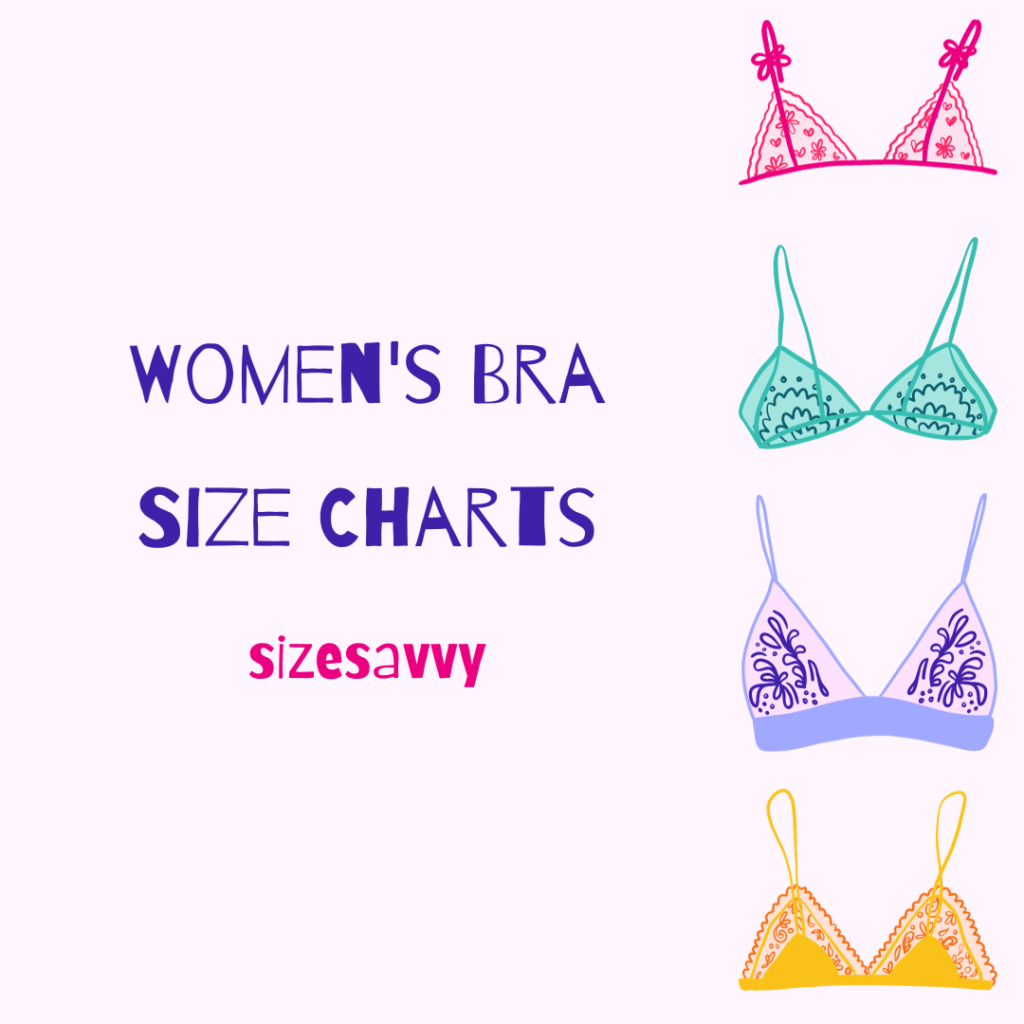
| Underbust (inches) | Underbust (cm) | Band Size (US/UK) | Bust Minus Band (inches) | Bust Minus Band (cm) | Cup Size (US/UK) | Cup Size (EU) |
| 24-25 | 61-63 | 28 | 0-1 | 0-2 | AA/A | A |
| 26-27 | 66-69 | 30 | 1-2 | 2-5 | A | A/B |
| 28-29 | 71-74 | 32 | 2-3 | 5-7.5 | B | B/C |
| 30-31 | 76-79 | 34 | 3-4 | 7.5-10 | C | C/D |
| 32-33 | 81-84 | 36 | 4-5 | 10-12.5 | D | D/E |
| 34-35 | 86-89 | 38 | 5-6 | 12.5-15 | DD/E | E/F |
| 36-37 | 91-94 | 40 | 6-7 | 15-17.5 | DDD/F | F/G |
| 38-39 | 96-99 | 42 | 7-8 | 17.5-20 | G | G/H |
| 40-41 | 101-104 | 44 | 8-9 | 20-22.5 | H | H/I |
| 42-43 | 106-109 | 46 | 9-10 | 22.5-25 | I | I/J |
| 44-45 | 111-114 | 48 | 10-11 | 25-27.5 | J | J/K |
| 46-47 | 116-119 | 50 | 11-12 | 27.5-30 | K | K/L |
Please note that sizing can vary slightly between brands and countries,
Bra Sizes for Kids
| Age Group | Underbust (inches) | Underbust (cm) | Band Size (US/UK) | Cup Size (US/UK) |
| 8-10 years | 22-24 | 56-61 | 24 | AA/A |
| 10-12 years | 24-26 | 61-66 | 26 | A/B |
| 12-14 years | 26-28 | 66-71 | 28 | B/C |
| 14-16 years | 28-30 | 71-76 | 30 | C/D |
Please note sizing can vary,
Bra Sizes for Teenagers
| Age Group | Underbust (inches) | Underbust (cm) | Band Size (US/UK) | Cup Size (US/UK) |
| 16-18 years | 30-32 | 76-81 | 32 | B/C |
| 18-20 years | 32-34 | 81-86 | 34 | C/D |
| 20-22 years | 34-36 | 86-91 | 36 | D/DD |
sizing can vary by brand and region,
Choosing the Right Size Bra
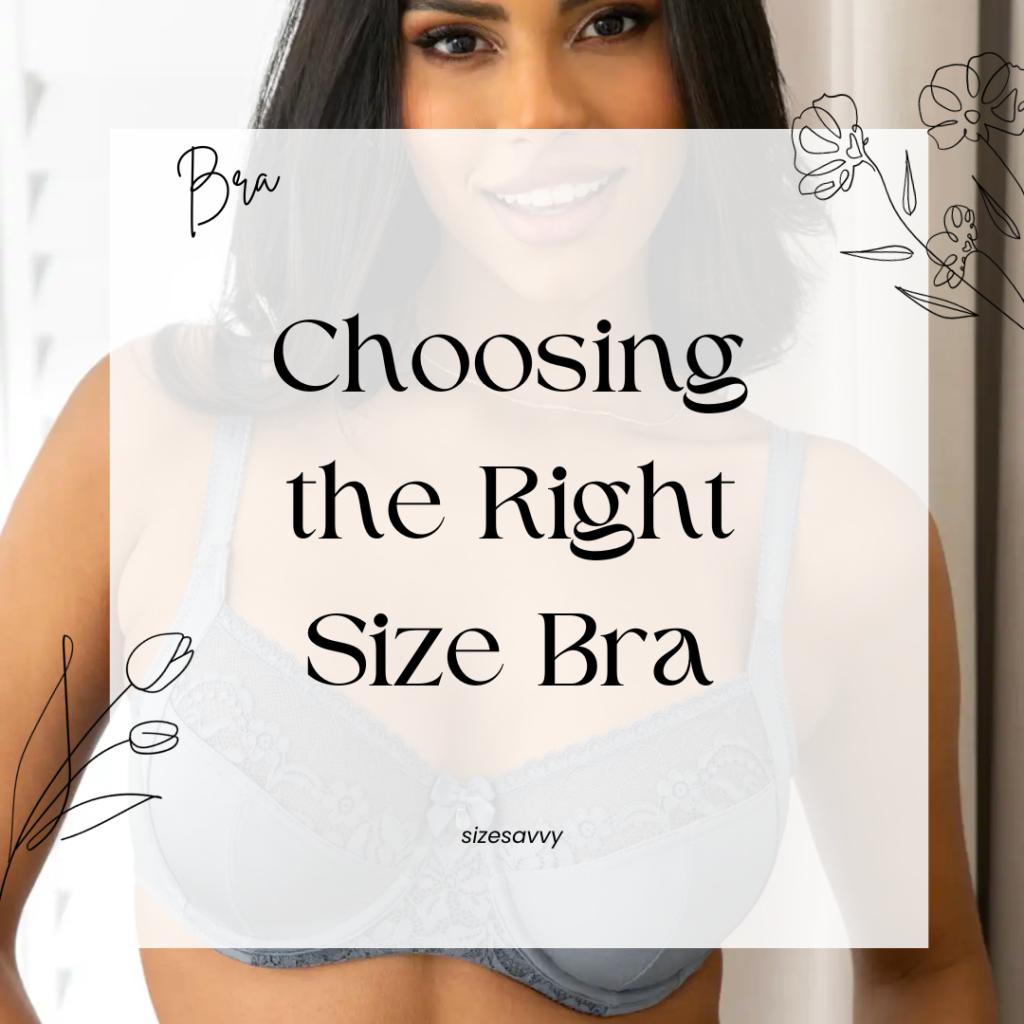
Choosing the right bra size is not just about numbers;
- Measure, Don’t Guess: Don’t rely on assumptions. Measure your band size by wrapping a tape measure snugly under your bust. For the cup size, measure around the fullest part of your breasts. Many lingerie stores offer free measuring services.
- Understand Band Size: Your band should sit firmly around your ribcage without digging in. If it rides up your back, it’s too loose. The band provides 80% of the bra’s support, so getting this right is crucial.
- Crack the Cup Code: Cup size is not universal. It varies concerning band size. A ‘C’ cup on a 32-band size is smaller than a ‘C’ cup on a 36-band size. Understanding this ensures the right proportion.
- Consider Your Breast Shape: Breasts come in various shapes – round, teardrop, asymmetrical, etc. Different styles cater to different shapes. For example, balconette bras lift round breasts, while full-cup bras offer better support for teardrop shapes.
- Think About Your Lifestyle: Your activities impact your choice. Sports bras provide extra support for workouts, while seamless bras are great for everyday wear, ensuring no lines under clothing.
- Adjustable Straps Matter: Straps should stay in place without digging into your shoulders. Adjustable straps are a boon, allowing you to customize the fit according to your body shape and outfit.
- Check for Comfort: Always try before you buy. Move around, raise your arms, and bend over. Your bra should stay in place and keep you comfortable in all positions.
- Regularly Reassess: Your body changes over time due to various factors like weight fluctuations and pregnancy. So, reassess your size every six months or if you notice any discomfort.
Remember, a well-fitted bra enhances your posture, provides adequate support, and boosts your confidence.
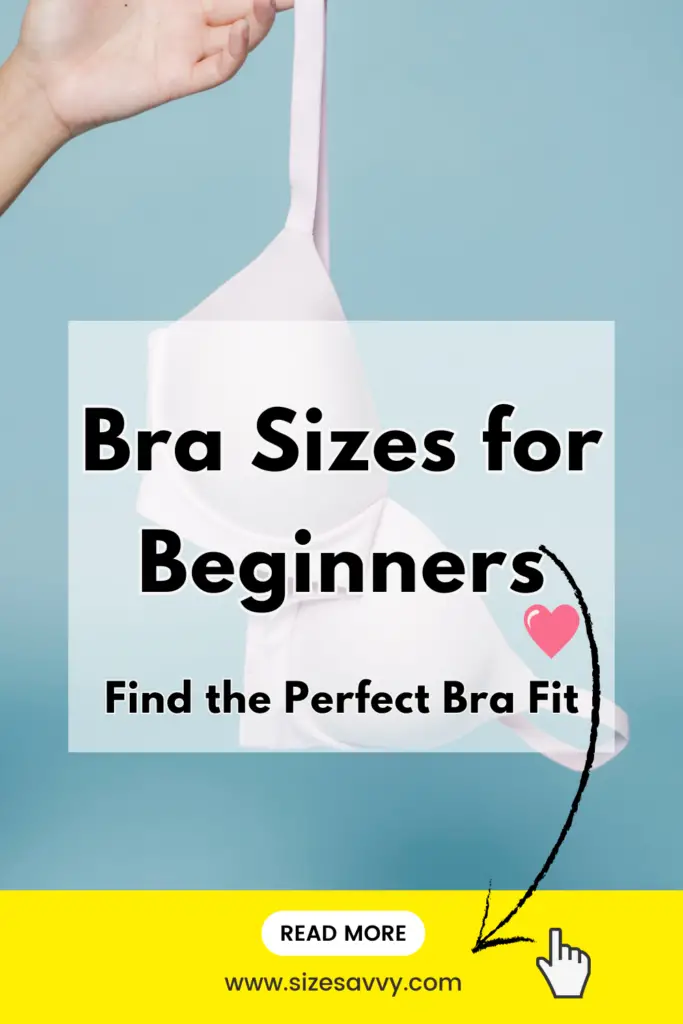
The Perfect Bra for Every Outfit
When it comes to fashion, one size doesn’t fit all, and the same applies to bras!
1. T-Shirt Bras for Seamless Style:
- Ideal For: Fitted t-shirts, thin fabrics.
- Why: No seams or lines, ensuring a smooth look.
- Tip: Opt for a nude or neutral shade for versatility.
2. Push-Up Bras for Glamorous Evenings:
- Ideal For: Low-cut dresses, party wear.
- Why: Lifts and enhances, creating a flattering cleavage.
- Tip: Choose lace or embellished designs for added elegance.
3. Sports Bras for Active Days:
- Ideal For: Workouts, sports activities.
- Why: Maximum support, minimizing bounce during movement.
- Tip: Look for breathable, moisture-wicking fabric for comfort.
4. Strapless Bras for Shoulder-Baring Styles:
- Ideal For: Off-shoulder tops, strapless dresses.
- Why: No visible straps, allowing your shoulders to shine.
- Tip: Silicone-lined bands provide extra grip and prevent slipping.
5. Bralettes for Effortless Chic:
- Ideal For: Casual wear, light activities.
- Why: Comfortable, trendy, and often stylishly designed.
- Tip: Layer under sheer tops or low-cut blouses for a boho vibe.
6. Plunge Bras for Deep Necklines:
- Ideal For: Plunging necklines, V-neck dresses.
- Why: Offers a deep, flattering neckline without compromising support.
- Tip: Wide-set straps work best with this style of bra.
7. Convertible Bras for Versatility:
- Ideal For: Multiway outfits, halter necks, crisscross backs.
- Why: Straps can be adjusted and detached for various styles.
- Tip: Invest in a high-quality one with durable clasps and comfortable fabric.
Remember, the right bra enhances your outfit, ensuring you look and feel confident. also, check out Best Bra for Saree.
Choosing the Right Fabric for Your Bra
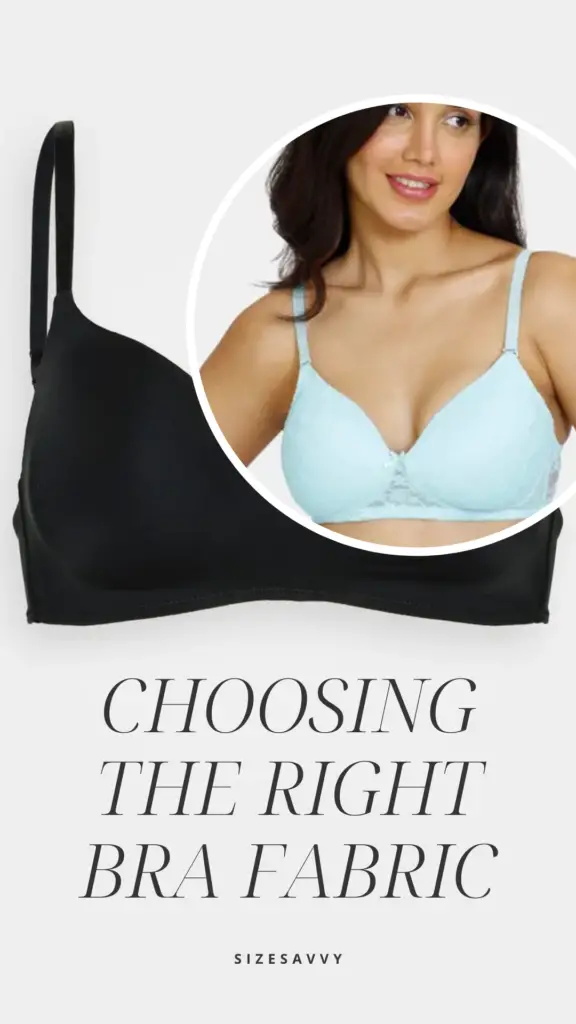
When it comes to bras, the fabric plays a crucial role in determining comfort, support, and durability.
1. Cotton:
- Ideal For: Everyday wear, especially in hot climates.
- Why: Breathable, soft, and hypoallergenic, making it perfect for sensitive skin.
- Tip: Look for blended fabrics with cotton for added stretch and support.
2. Lace:
- Ideal For: Fashion bras, special occasions.
- Why: Adds a touch of elegance, is lightweight, and provides a feminine appeal.
- Tip: Opt for bras with a cotton lining behind the lace for comfort against the skin.
3. Spandex/Elastane:
- Ideal For: Bras that need stretch and flexibility.
- Why: Offers excellent elasticity, ensuring a snug fit and freedom of movement.
- Tip: Check the percentage of spandex – a higher percentage provides more stretch.
4. Microfiber:
- Ideal For: Seamless bras, daily wear.
- Why: Smooth texture, lightweight, and provides a sleek look under clothing.
- Tip: Resistant to wrinkles and shrinking, making it a durable choice.
5. Mesh:
- Ideal For: Sports bras, breathable everyday wear.
- Why: Highly breathable, wicks away moisture, and keeps you cool.
- Tip: Look for bras with mesh panels for strategic ventilation.
6. Silk:
- Ideal For: Luxury bras, special occasions.
- Why: Luxuriously soft, hypoallergenic, and offers a natural sheen.
- Tip: Hand wash silk bras to maintain their delicate fibers.
7. Modal:
- Ideal For: Eco-conscious consumers, everyday wear.
- Why: Made from plant-based fibers, it’s incredibly soft, smooth, and eco-friendly.
- Tip: Modal blends offer enhanced durability and moisture-wicking properties.
Consider your lifestyle, skin sensitivity, and personal preferences when choosing the fabric for your bras.
Conclusion: Finding the perfect bra size is an empowering journey. It’s not just a number; it’s about feeling confident, supported, and comfortable. Armed with accurate measurements and an understanding of standard sizes, you’re ready to embark on this transformative experience. Your perfect bra is out there, waiting to enhance your style and boost your confidence!
FAQs on Bra Sizes
What is ABCD in bra size?
ABCD in bra size represents different cup sizes. ‘A’ is smaller than ‘B,’ ‘B’ is smaller than ‘C,’ and ‘C’ is smaller than ‘D.’
What is bigger, cup A or B?
Cup size B is bigger than cup size A.
Which breast size is good?
Breast size is subjective and varies for each individual. There is no universal definition of a “good” breast size. What matters most is comfort and confidence in your own body.
Is size C in a bra big?
Bra size ‘C’ is considered average. Breast size perception varies, and what one person considers big, another might consider small. It’s all relative to individual perspectives.
Which bra size is bigger: A, B, C, or D?
Bra sizes are ordered from smallest to largest as A, B, C, and D. Each letter represents an increase in cup size.
Is bra size C smaller than B?
No, bra size C is larger than bra size B. The progression is A < B < C in terms of cup size.
Which is bigger, 34B or 34C?
34C is larger than 34B. The number ’34’ represents the band size, which is the same in both cases.
Is 34 or 36 a bigger bra size?
A 36-band size is larger than a 34-band size. The number denotes the measurement around the ribcage under the bust.
Is 32C bra size good?
Yes, 32C is a common and average bra size. It’s important to wear a size that is comfortable and provides proper support.
Can I wear 36B if I’m 34B?
Generally, it’s recommended to wear your correct band size for the best fit. If you find that a 36B offers a more comfortable fit, it’s your personal choice, but it may not provide optimal support.
What is the smallest bra size?
Bra sizes start from AAA (triple A) and progress to larger cup sizes like AA, A, B, C, and so on. AAA is considered the smallest cup size.
What is a normal bra size?
There is no “normal” bra size as sizes vary widely among individuals. A normal bra size provides comfort, and support and fits well according to an individual’s body shape and measurements.
What size bra for a girl?
Bra sizes for girls typically start from AA or AAA, and as they grow, they may progress to larger cup sizes like A, B, and beyond. Girls need to wear bras that are comfortable and supportive, regardless of the size.
Am I cup size A or B?
To determine your cup size, measure your bust (the fullest part of your chest) and your underbust (around your ribcage right under your bust). The difference between these measurements corresponds to your cup size. Consult a bra sizing chart for accurate sizing guidance.

